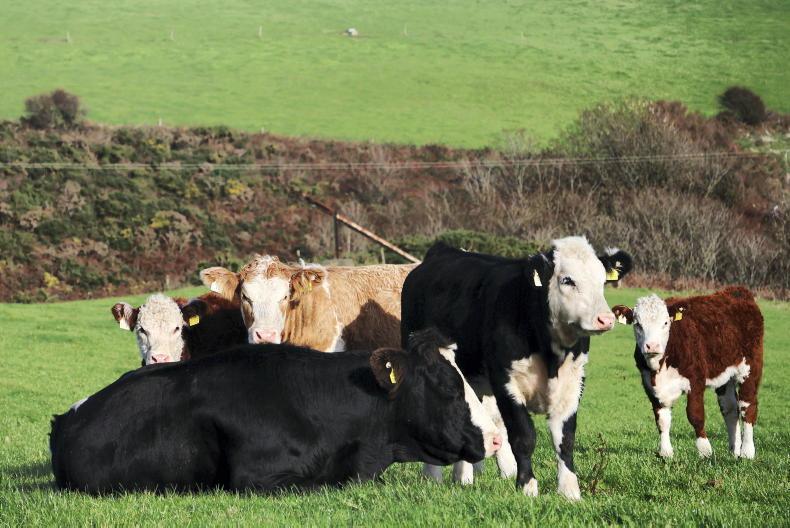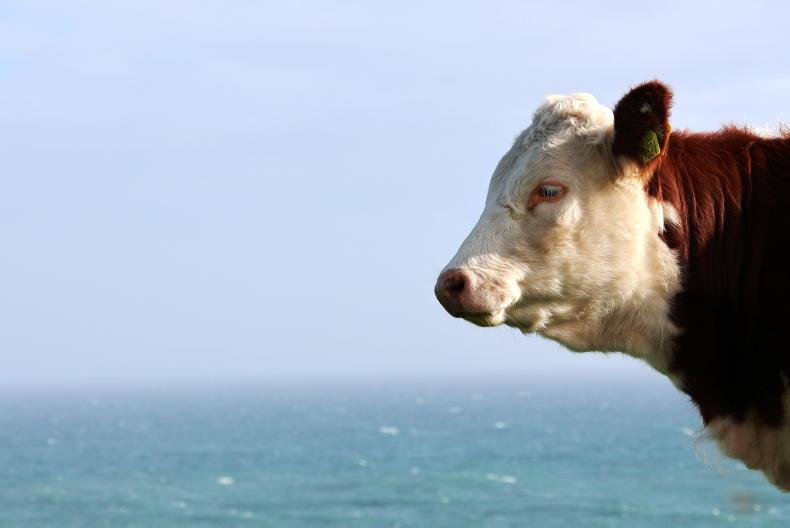Only weeks ago, we were looking forward to a drop of rain to kick-start grass growth, now it would be nice if it stopped.
Rainfall levels had been below average for most of the year so it was inevitable that it would balance out at some point.
Weaning has passed the halfway point and the bull weanlings were introduced to ration at the weekend. Due to the rain, about half of the herd is housed, and to reduce the risk of ground getting chopped those that are outside are in smaller groups. Depending on the weather some of the weaned cows will go back out for a few weeks to do a clean-up of paddocks.

Some heifer calves remain unweaned on Tommy Moyles' farm at Ardfield, Clonakilty, Co Cork.
The damp warm weather in the middle of October provided its own grazing challenges in fields with high clover content. After no cases since 2019, I nearly had a pair of animals with bloat a fortnight ago, nearly being the important word. One weanling bull was tubed to release gas and 36 hours later, I spotted a cow with her stomach bulging out on her left hand side. I called the vet and brought her in but by the time he arrived she had deflated herself. Maybe the walk to the yard worked the gas out. The plan we put in place to try and prevent scenarios like this involves staying clear of those paddocks with potenitally low fibre levels in blight-type conditions and hold them until the weather cools.

A heifer calf above the Atlantic horizon on Tommy Moyles' farm at Ardfield, Clonakilty, Co Cork.
Despite high clover contents in the swards on the farm, thankfully my experiences with bloat in cattle have been few. There was nothing until 2018 and 2019, when there were three cases late-on each year. On both occasions, one animal had it twice. Five cases were at grass and all when they were leaving a paddock, which I thought was unusual as it’s when they enter a new paddock that’s meant to be the riskiest period. The sixth case was a weanling who spotted ration in the shed long before the rest and subsequently needed veterinary attention. I was beginning to think it was a genetic thing, as those four weanlings came from the same cow family. The calf this year challenged that theory, but the cow was from the same line as the previous cases. It might be something to watch out for in future.
BEEP-S
With a replacement scheme being developed to replace BEEP-S, maybe there’s an opportunity to continue the work to reduce anthelmintic resistance and ramp up the faecal egg count element of it. To date, it has involved taking 10 individual dung samples which are then pooled at the lab to get a result.
I know it’s an introduction to the practice, but that form is a little self-defeating. Building on the previous incarnation, combined with a focus on getting farmers into organic farming, surely there’s merit in taking individual cow samples.

A cow grazing on Tommy Moyles' farm at Ardfield, Clonakilty, Co Cork.
If a farmer took samples from the 10 cows in poorest condition, there’s every chance a good proportion of the cows could have a low worm egg count or presence of fluke and wouldn’t need a dose. Having those results would give a farmer confidence in not having to blanket dose, especially if they are switching to organic and that option is removed. I realise it will come at a cost, but with new regulations regarding anti-parasitic products maybe there’s an opportunity for merchants to link up with labs in this regard.
Only weeks ago, we were looking forward to a drop of rain to kick-start grass growth, now it would be nice if it stopped.
Rainfall levels had been below average for most of the year so it was inevitable that it would balance out at some point.
Weaning has passed the halfway point and the bull weanlings were introduced to ration at the weekend. Due to the rain, about half of the herd is housed, and to reduce the risk of ground getting chopped those that are outside are in smaller groups. Depending on the weather some of the weaned cows will go back out for a few weeks to do a clean-up of paddocks.

Some heifer calves remain unweaned on Tommy Moyles' farm at Ardfield, Clonakilty, Co Cork.
The damp warm weather in the middle of October provided its own grazing challenges in fields with high clover content. After no cases since 2019, I nearly had a pair of animals with bloat a fortnight ago, nearly being the important word. One weanling bull was tubed to release gas and 36 hours later, I spotted a cow with her stomach bulging out on her left hand side. I called the vet and brought her in but by the time he arrived she had deflated herself. Maybe the walk to the yard worked the gas out. The plan we put in place to try and prevent scenarios like this involves staying clear of those paddocks with potenitally low fibre levels in blight-type conditions and hold them until the weather cools.

A heifer calf above the Atlantic horizon on Tommy Moyles' farm at Ardfield, Clonakilty, Co Cork.
Despite high clover contents in the swards on the farm, thankfully my experiences with bloat in cattle have been few. There was nothing until 2018 and 2019, when there were three cases late-on each year. On both occasions, one animal had it twice. Five cases were at grass and all when they were leaving a paddock, which I thought was unusual as it’s when they enter a new paddock that’s meant to be the riskiest period. The sixth case was a weanling who spotted ration in the shed long before the rest and subsequently needed veterinary attention. I was beginning to think it was a genetic thing, as those four weanlings came from the same cow family. The calf this year challenged that theory, but the cow was from the same line as the previous cases. It might be something to watch out for in future.
BEEP-S
With a replacement scheme being developed to replace BEEP-S, maybe there’s an opportunity to continue the work to reduce anthelmintic resistance and ramp up the faecal egg count element of it. To date, it has involved taking 10 individual dung samples which are then pooled at the lab to get a result.
I know it’s an introduction to the practice, but that form is a little self-defeating. Building on the previous incarnation, combined with a focus on getting farmers into organic farming, surely there’s merit in taking individual cow samples.

A cow grazing on Tommy Moyles' farm at Ardfield, Clonakilty, Co Cork.
If a farmer took samples from the 10 cows in poorest condition, there’s every chance a good proportion of the cows could have a low worm egg count or presence of fluke and wouldn’t need a dose. Having those results would give a farmer confidence in not having to blanket dose, especially if they are switching to organic and that option is removed. I realise it will come at a cost, but with new regulations regarding anti-parasitic products maybe there’s an opportunity for merchants to link up with labs in this regard.









 This is a subscriber-only article
This is a subscriber-only article










SHARING OPTIONS: